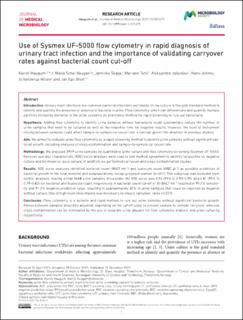| dc.description.abstract | Introduction. Urinary tract infections are common bacterial infections worldwide. Urine culture is the gold standard method to identify and quantify the presence or absence of bacteria in urine. Flow cytometry, which can differentiate and quantify multiple particles (including bacteria) in the urine, presents an alternative method for rapid screening to rule out bacteriuria. Hypothesis. Adding flow cytometry to identify urine samples without bacteriuria could substantially reduce the number of urine samples that need to be cultured as well as the response time for negative results. However, the level of instrument rinsing between samples could affect sample-to-sample carryover rate, a concept given little attention in previous studies. Aim. We aimed to evaluate urine flow cytometry as a rapid screening method to identify urine samples without significant bacterial growth, including analyses of cross-contamination and sample-to-sample carryover rate. Methodology. We analysed 3919 urine samples by quantitative urine culture and flow cytometry screening (Sysmex UF-5000). Receiver operator characteristic (ROC) curve analyses were used to test method agreement to identify: (a) positive vs. negative culture and (b) mixed vs. pure culture. In addition, we performed carryover and cross-contamination studies. Results. ROC curve analyses identified bacterial count (BACT ml−1) and leucocyte count (WBC µl−1) as possible predictors of bacterial growth in the total material and subpopulations, except pregnant women (n=451). This subgroup was excluded from further analyses, leaving a final 3468 urine samples. Area under the ROC curve was 0.94 (95% CI 0.93–0.95) and 0.81 (95% CI 0.79–0.82) for bacterial and leucocyte count, respectively. A bacterial count cut-off of 30 BACT ml−1 resulted in 95.2% sensitivity and 91.2% negative predictive value, resulting in approximately 30% of urine samples that could be reported as negative without culture. Use of high-level rinse modes was necessary to ensure carryover rates <0.05%. Conclusion. Flow cytometry is a suitable and rapid method to rule out urine samples without significant bacterial growth. Rinses between samples should be adjusted, depending on the cut-off used, to prevent sample-to-sample carryover, whereas cross-contamination can be eliminated by the use of separate urine aliquots for flow cytometry analysis and urine culturing respectively | en_US |

